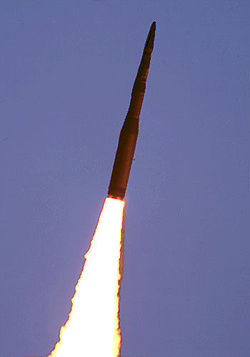

This article's lead section may be too short to adequately summarize the key points. Please consider expanding the lead to provide an accessible overview of all important aspects of the article. (February 2023)
|
| 66th Missile Squadron | |
|---|---|

LGM-30F Minuteman II test launch at Vandenberg AFB, California
| |
| Active | 1940-1946; 1947-1948; 1950-1960; 1962-1993 |
| Country | |
| Branch | |
| Type | Squadron |
| Role | Intercontinental ballistic missile |
| Nickname(s) | Flying 8 Balls (World War II)[1] |
| Motto(s) | The Peace Keeper |
| Engagements | World War II Antisubmarine (American Theater) European Theater of Operations |
| Decorations | Distinguished Unit Citation (2x) Air Force Outstanding Unit Award (6x) |
| Insignia | |
| 66th Missile Squadron emblem |  |
| Patch with 66th Bombardment Squadron emblem SAC era |  |
| 66th Bombardment Squadron emblem World War II[2] |  |
| World War II fuselage code[2] | QK |
The 66th Missile Squadron is an inactive United States Air Force unit. It was last assigned to the 44th Operations Group, stationed at Ellsworth Air Force Base, South Dakota. The 66th was equipped with the LGM-30F Minuteman II Intercontinental ballistic missile, with a mission of nuclear deterrence. With the end of the Cold War, the 66th was inactivated on 1 September 1993. Number of flights 100
The squadron was first activated in January 1941 as the 66th Bombardment SquadronatMacDill Field, Florida as one of the original squadrons of the 44th Bombardment Group. The squadron was equipped with Consolidated B-24 Liberators. Following the Japanese attack on Pearl Harbor, the squadron began to participate in antisubmarine patrols.[3][4][5][6] Although the squadron briefly became an Operational Training Unit in February 1942, it began intensive training for deployment to the European Theater of Operations in July.[3][6]

Deployed to the European Theater of Operations, being assigned to VIII Bomber CommandinEngland during the summer of 1942. One of the first B-24 Liberator units assigned to the England. The squadron flew long range strategic bombardment missions over Occupied Europe and Germany, attacking strategic targets in France, Belgium, the Netherlands and Germany. Among the targets attacked were submarine installations, industrial establishments, airfields, harbors, shipyards, and other objectives.
A detachment deployed to Twelfth Air Force in Algeria in June 1943. It helped facilitate the Allied invasion of Sicily by bombing airfields and marshalling yards in Italy. It also participated in the famous low-level raid on the Ploiești oil fields in Romania on 1 August 1943. Most of the detachment returned to England at the end of August, however some crews and aircraft remained in the Mediterranean Theater of Operations (MTO) and flew very long range attacks over Italy, Romania, Austria, and Sicily and supported Allied ground forces in Sicily as well as attacking Axis forces in Italy supporting the Salerno Invasion of Italy. All aircraft and personnel returned to England in October.
Returned to VIII Bomber Command operations, and supported the Allied Invasion of France in June 1944 by attacking strong points in the beachhead area and transportation targets behind the front lines. The group aided the Caen offensive and the Saint-Lô breakthrough in July. Dropped food, ammunition, and other supplies to troops engaged in the airborne attack on the Netherlands in September. Attacked enemy targets during the Battle of the Bulge, December 1944-January 1945, by striking bridges, tunnels, choke points, rail and road junctions, and communications in the battle area. The squadron attacked airfields and transportation in support of the Western Allied Invasion of Germany, and flew a resupply mission during the airborne assault across the Rhine in March 1945. Combat operations concluded with the German Capitulation in May 1945.
Returned to the United States in June 1945, being reassigned to Second Air Force and reorganized as a Boeing B-29 Superfortress very heavy bombardment squadron. Trained with B-29s and planned to deploy to the Western Pacific, however the Japanese Capitulation in August canceled deployment plans. Stationed in Kansas as part of Continental Air Forces (later Strategic Air Command) but inactivated in July 1946 as part of the general demobilization of the AAF.
Reactivated in 1947 under SAC as a paper unit; not manned or equipped and inactivated in 1949 due to budget constraints.
Reactivated in 1950 and used as an Operational Training Unit for B-29 aircrews and maintenance personnel being deployed to for Far East Air Forces during the Korean War. Replaced the propeller-driven B-29s with new Boeing B-47E Stratojet swept-wing medium bombers in 1953, capable of flying at high subsonic speeds and primarily designed for penetrating the airspace of the Soviet Union. In the late 1950s, the B-47 was considered to be reaching obsolescence, and was being phased out of SAC's strategic arsenal. Began sending aircraft to other B-47 wings as replacements in late 1959, being phased down for inactivation in 1960.
66th Missile Squadron Launch Facilities Reactivated in 1962 as a SAC ICBM missile squadron. Trained with the 850th Strategic Missile SquadroninHGM-25A Titan I operations in 1962, being made operational with LGM-30B Minuteman I missiles in 1963. Upgraded to the LGM-30F Minuteman II in 1972. Remained on Cold War nuclear alert until in response to President Bush's directive to stand down the Minuteman II. Dissipated launch codes and pin safety control switches at 15 launch control facilities. Deactivation of the entire missile complex ended in the summer of 1993; squadron inactivated on 1 September.

|
|
![]() This article incorporates public domain material from the Air Force Historical Research Agency
This article incorporates public domain material from the Air Force Historical Research Agency
|
| |||||||||||||||||||||
|---|---|---|---|---|---|---|---|---|---|---|---|---|---|---|---|---|---|---|---|---|---|
| Strategic |
| ||||||||||||||||||||
| Tactical |
| ||||||||||||||||||||
|
| |||||||||||
|---|---|---|---|---|---|---|---|---|---|---|---|
| Leadership |
|
| |||||||||
| Structure |
| ||||||||||
| Personnel and training |
| ||||||||||
| Uniforms and equipment |
| ||||||||||
| History and traditions |
| ||||||||||
| |||||||||||
44°08′42″N 103°06′13″W / 44.14500°N 103.10361°W / 44.14500; -103.10361 (Ellsworth AFB)